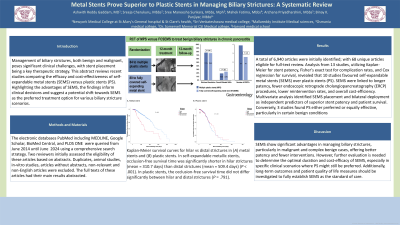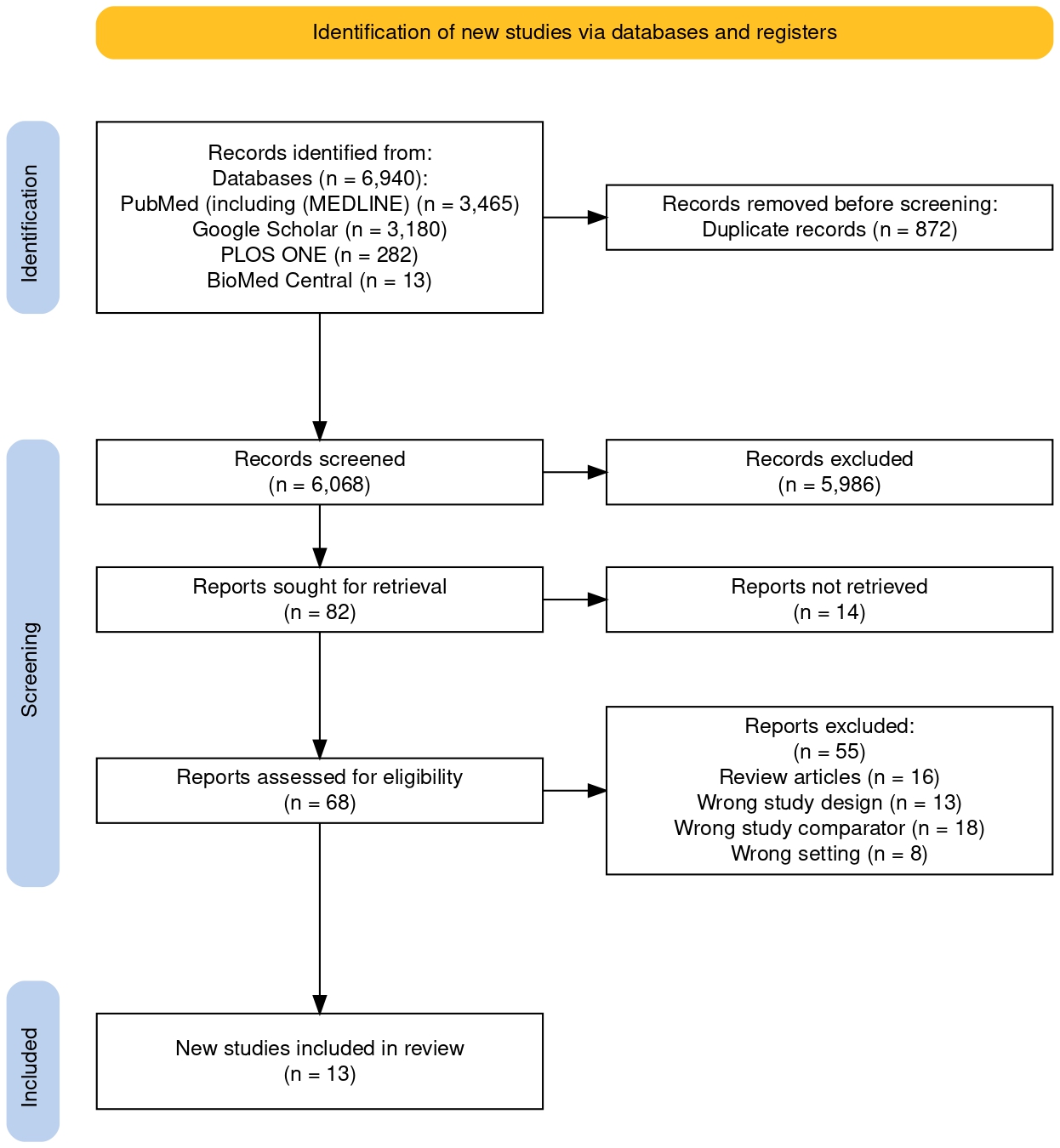Tuesday Poster Session
Category: Biliary/Pancreas
P3445 - Metal Stents Prove Superior to Plastic Stents in Managing Biliary Strictures: A Systematic Review
Tuesday, October 29, 2024
10:30 AM - 4:00 PM ET
Location: Exhibit Hall E

Has Audio
- AG
Ashwith Reddy Gaddam, MD
University of Kansas Medical Center
Kamareddy, Telangana, India
Presenting Author(s)
Ashwith Reddy Gaddam, MD1, Sreeja Cherukuru, MBBS2, Sree Maneesha Sunkara, MBBS, MPH.3, Mahek Fatima, MBBS4, Archana Priyadarsini, MBBS5, Binay K. Panjiyar, MBBS6
1University of Kansas Medical Center, Kamareddy, Telangana, India; 2Sri Venkateswara Medical College, Tirupati, Andhra Pradesh, India; 3Malla Reddy Institute of Medical Sciences, Ashland, MA; 4Osmania General Hospital and Medical College, Hyderabad, Telangana, India; 5Dr Somervell Memorial CSI Medical College, Missouri City, TX; 6Harvard Medical School, Boston, MA
Introduction: Management of biliary strictures, both benign and malignant, poses significant clinical challenges, with stent placement being a key therapeutic strategy. This abstract reviews recent studies comparing the efficacy and cost-effectiveness of self-expandable metal stents (SEMS) versus plastic stents (PS). Highlighting the advantages of SEMS, the findings inform clinical decisions and suggest a potential shift towards SEMS as the preferred treatment option for various biliary stricture scenarios.
Methods: The electronic databases PubMed including MEDLINE, Google Scholar, BioMed Central, and PLOS ONE were queried from June 2014 until June 2024 using a comprehensive search strategy. Two reviewers initially assessed the eligibility of these articles based on abstracts. Duplicates, animal studies, in-vitro studies, articles without abstracts, non-relevant and non-English articles were excluded. The full texts of these articles had their main results abstracted.
Results: A total of 6,940 articles were initially identified; with 68 unique articles eligible for full-text review. Analysis from 13 studies, utilizing Kaplan-Meier for stent patency, Fisher's exact test for complication rates, and Cox regression for survival, revealed that 10 studies favoured self-expandable metal stents (SEMS) over plastic stents (PS). SEMS were linked to longer patency, fewer endoscopic retrograde cholangiopancreatography (ERCP) procedures, lower reintervention rates, and overall cost-efficiency. Multivariate analysis identified SEMS placement and bilateral deployment as independent predictors of superior stent patency and patient survival. Conversely, 3 studies found PS either preferred or equally effective, particularly in certain benign conditions.
Discussion: SEMS show significant advantages in managing biliary strictures, particularly in malignant and complex benign cases, offering better patency and fewer interventions. However, further evaluation is needed to determine the optimal duration and cost-efficacy of SEMS, especially in specific clinical scenarios where PS might still be preferred. Additionally, long-term outcomes and patient quality of life measures should be investigated to fully establish SEMS as the standard of care.

Disclosures:
Ashwith Reddy Gaddam, MD1, Sreeja Cherukuru, MBBS2, Sree Maneesha Sunkara, MBBS, MPH.3, Mahek Fatima, MBBS4, Archana Priyadarsini, MBBS5, Binay K. Panjiyar, MBBS6. P3445 - Metal Stents Prove Superior to Plastic Stents in Managing Biliary Strictures: A Systematic Review, ACG 2024 Annual Scientific Meeting Abstracts. Philadelphia, PA: American College of Gastroenterology.
1University of Kansas Medical Center, Kamareddy, Telangana, India; 2Sri Venkateswara Medical College, Tirupati, Andhra Pradesh, India; 3Malla Reddy Institute of Medical Sciences, Ashland, MA; 4Osmania General Hospital and Medical College, Hyderabad, Telangana, India; 5Dr Somervell Memorial CSI Medical College, Missouri City, TX; 6Harvard Medical School, Boston, MA
Introduction: Management of biliary strictures, both benign and malignant, poses significant clinical challenges, with stent placement being a key therapeutic strategy. This abstract reviews recent studies comparing the efficacy and cost-effectiveness of self-expandable metal stents (SEMS) versus plastic stents (PS). Highlighting the advantages of SEMS, the findings inform clinical decisions and suggest a potential shift towards SEMS as the preferred treatment option for various biliary stricture scenarios.
Methods: The electronic databases PubMed including MEDLINE, Google Scholar, BioMed Central, and PLOS ONE were queried from June 2014 until June 2024 using a comprehensive search strategy. Two reviewers initially assessed the eligibility of these articles based on abstracts. Duplicates, animal studies, in-vitro studies, articles without abstracts, non-relevant and non-English articles were excluded. The full texts of these articles had their main results abstracted.
Results: A total of 6,940 articles were initially identified; with 68 unique articles eligible for full-text review. Analysis from 13 studies, utilizing Kaplan-Meier for stent patency, Fisher's exact test for complication rates, and Cox regression for survival, revealed that 10 studies favoured self-expandable metal stents (SEMS) over plastic stents (PS). SEMS were linked to longer patency, fewer endoscopic retrograde cholangiopancreatography (ERCP) procedures, lower reintervention rates, and overall cost-efficiency. Multivariate analysis identified SEMS placement and bilateral deployment as independent predictors of superior stent patency and patient survival. Conversely, 3 studies found PS either preferred or equally effective, particularly in certain benign conditions.
Discussion: SEMS show significant advantages in managing biliary strictures, particularly in malignant and complex benign cases, offering better patency and fewer interventions. However, further evaluation is needed to determine the optimal duration and cost-efficacy of SEMS, especially in specific clinical scenarios where PS might still be preferred. Additionally, long-term outcomes and patient quality of life measures should be investigated to fully establish SEMS as the standard of care.

Figure: Figure 1. PRISMA flow diagram detailing the article screening process.
Disclosures:
Ashwith Reddy Gaddam indicated no relevant financial relationships.
Sreeja Cherukuru indicated no relevant financial relationships.
Sree Maneesha Sunkara indicated no relevant financial relationships.
Mahek Fatima indicated no relevant financial relationships.
Archana Priyadarsini indicated no relevant financial relationships.
Binay Panjiyar indicated no relevant financial relationships.
Ashwith Reddy Gaddam, MD1, Sreeja Cherukuru, MBBS2, Sree Maneesha Sunkara, MBBS, MPH.3, Mahek Fatima, MBBS4, Archana Priyadarsini, MBBS5, Binay K. Panjiyar, MBBS6. P3445 - Metal Stents Prove Superior to Plastic Stents in Managing Biliary Strictures: A Systematic Review, ACG 2024 Annual Scientific Meeting Abstracts. Philadelphia, PA: American College of Gastroenterology.
